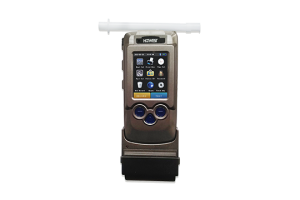Principles of Operation:
Alcohol detection devices, commonly known as breathalyzers, operate on the principle of detecting the concentration of alcohol in a person’s breath to estimate their blood alcohol concentration (BAC). They typically use a chemical reaction or an electrochemical fuel cell to measure the amount of ethanol present.
Breath Analysis: When a person exhales into the device, any alcohol present in their breath reacts with the sensor. This reaction generates an electric current or a color change, which the device measures and translates into a BAC reading.
Types of Alcohol Detection Devices:
1. Semi-conductor Sensor Devices: These devices use a semiconductor oxide sensor to detect alcohol molecules. As alcohol comes into contact with the sensor, it causes a change in electrical resistance, which is then measured to determine BAC levels.
2. Fuel Cell Sensor Devices: Employing an electrochemical reaction, these devices oxidize the alcohol present in the breath sample. This reaction generates an electric current, the strength of which corresponds to the alcohol concentration, allowing for an accurate BAC reading.
Precautions when Using Alcohol Detection Devices:
1. Calibration: Ensure that the device is regularly calibrated according to the manufacturer’s guidelines for accurate readings.
2. Environmental Conditions: Extreme temperatures or humidity can affect the device’s accuracy. Use it within the recommended temperature and humidity range specified by the manufacturer.
3. Use with Care: Follow the device’s instructions carefully. Improper use, such as blowing too hard or too softly into the device, can impact the accuracy of the readings.
4.Maintenance: Keep the device clean and well-maintained. Regularly clean the mouthpiece or sensor area as per the instructions to prevent any residue buildup that could affect readings.
5. Interference: Avoid using the device in the presence of substances like mouthwash, breath fresheners, or certain medications that might interfere with the readings.
6. Battery Power: Ensure the device has sufficient battery power before use. Low battery levels might affect the accuracy of the readings.
7. Confirmation: Breathalyzers are intended as screening tools and not as legal evidence. If used for legal purposes, confirm results with a certified testing facility or law enforcement.
Conclusion:
Alcohol detection devices serve as useful tools to estimate alcohol levels, but they have limitations and require proper handling and maintenance for accurate readings. Always use them as guidance and consult a professional for precise and legally binding results.


Please contact us for free quotation by form below. We promise the quickest response within 24 hours: